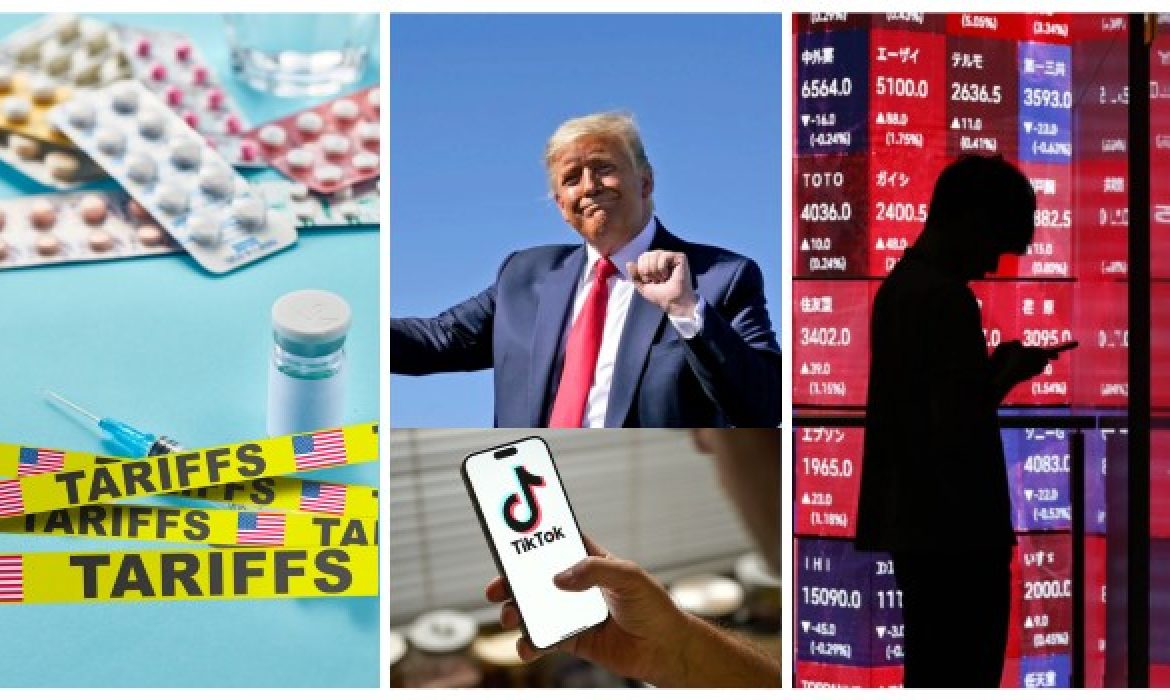
Date Issued – 25th September 2025
Courtesy of the Research Department at Balfour Capital Group
Key Points
- U.S. to impose 100% tariffs on branded pharmaceuticals from Oct. 1: Pressures global supply chains and drugmakers reliant on overseas production.
- Trump approves $14B TikTok U.S. deal: Oracle and investors take control while ByteDance’s stake falls below 20%.
- Washington to enforce 25% tariffs on heavy truck imports: Expands trade measures to protect domestic manufacturers.
- Asian pharma stocks dropped sharply: Japanese, Korean, and Hong Kong-listed firms lead declines after U.S. drug tariff announcement.
U.S. to Levy 100% Tariff on Branded Drugs to Spur Local Production
The U.S. will impose a 100% tariff on all branded and patented pharmaceuticals starting October 1, unless manufacturers are actively building plants domestically, in a bid to reshore drug production.
The move follows a Section 232 investigation into pharmaceuticals and adds to Trump’s broader tariff strategy targeting critical imports. With U.S. pharma imports at $213 billion in 2024, the measure risks raising drug costs and worsening shortages, while adding pressure to global supply chains. Companies with larger U.S. manufacturing footprints, such as Eli Lilly and AbbVie, may be better positioned than peers like Novartis and Roche to absorb the impact.
Trump Approves $14B TikTok U.S. Deal With Oracle-Led Investors
President Trump approved a deal to keep TikTok operating in the U.S., signing an executive order that establishes a new joint-venture company valued at $14 billion.
Under the terms, Oracle, Silver Lake, and Abu Dhabi’s MGX will hold about 45% of the U.S. entity, while ByteDance’s stake falls below 20%, pending Chinese government approval.
Oracle will manage security operations and cloud services, reinforcing U.S. oversight of the platform. The move averts a looming ban under national security laws but leaves uncertainties around regulatory approval in Beijing and the long-term valuation of TikTok’s U.S. business relative to ByteDance’s global assets.
U.S. Imposes 25% Tariffs on Heavy Truck Imports Starting Oct. 1
The U.S. will impose a 25% tariff on imported heavy trucks from October 1, expanding President Trump’s Section 232 tariff agenda aimed at bolstering domestic manufacturing.
Mexico, Canada, Japan, Germany, and Turkey—key suppliers of medium- and heavy-duty trucks—are likely to be most affected. Additional duties include 100% tariffs on branded drugs, 50% on kitchen cabinets, and 30% on upholstered furniture, signaling a broader escalation in trade barriers.
While U.S. heavy-truck production has rebounded since 2020, analysts caution that high input costs and lack of tariff offsets could limit the benefits to domestic manufacturers, potentially raising prices for buyers.
Asian Pharma Stocks Slide After U.S. Drug Tariff Announcement
Asian pharmaceutical stocks extended losses after Trump announced 100% tariffs on branded drugs effective October 1, adding pressure to an already volatile sector.
Japan’s Topix Pharma Index dropped 1.47%, with Daiichi Sankyo, Chugai, and Sumitomo Pharma leading declines, while South Korea’s Samsung Biologics and SK Bio Pharmaceuticals fell 1.7% and 3.7%. Hong Kong-listed Alibaba Health and JD Health also retreated.
Regional equity markets were mixed, with South Korea’s Kospi down over 2% and Hong Kong’s Hang Seng off 0.9%, while Japan’s Topix hit a fresh record on softer-than-expected Tokyo inflation data, underscoring diverging investor sentiment across Asia.
Conclusion
Global markets face renewed volatility as U.S. trade policy intensifies and sector-specific tariffs reshape supply chain risks. The 100% levy on branded pharmaceuticals and 25% duties on heavy trucks highlight Washington’s push to reshore production, though the measures raise concerns over higher costs and supply disruptions.
Meanwhile, Trump’s approval of a $14 billion TikTok deal underscores continued scrutiny of Chinese-linked technology assets. In Asia, pharma stocks retreated on tariff fears, while broader equity moves reflected mixed signals from inflation and yields. Investors must navigate rising policy-driven headwinds while monitoring opportunities in sectors positioned for resilience or structural growth.
Investment Insights
- Tariffs on branded drugs and heavy trucks increase cost pressures: Investors should reassess exposure to supply chains reliant on imports.
- The TikTok deal highlights U.S. scrutiny of Chinese tech assets: Reinforces the importance of monitoring regulatory risk in cross-border investments.
- Domestic manufacturers may see short-term support: Protectionist policies could offer a boost, though input costs and supply disruptions may offset gains.
- Asia’s pharma sector weakness underscores tariff spillover risks: Diverging inflation trends in Japan suggest selective opportunities in regional equities.
Economic Calendar
| Date | Event | Why It Matters |
|---|---|---|
| September 26, 2025 | U.S. PCE Price Index (August) | Fed’s preferred inflation gauge; key for shaping monetary policy expectations. |
| September 26, 2025 | U.S. Durable Goods Orders & New Home Sales | Measures investment and housing demand, key for growth outlook. |
| September 30, 2025 | U.S. Advance GDP & Chicago PMI | Snapshot of Q3 growth momentum and manufacturing activity. |
| October 2, 2025 | U.S. Initial Jobless Claims | Weekly labor market indicator, influencing Fed policy trajectory. |
| Early October 2025 | Eurozone Manufacturing & Services PMI | Key barometer of eurozone growth and business confidence, closely tracked by ECB. |
Disclaimer: This newsletter provides financial insights for informational purposes only. It does not constitute financial advice or recommendations for investment decisions.




